Somerset Constabulary 1856-1967
Somerset Constabulary was created with a full strength of 260 constables following the County and Borough Police Act of 1856. The headquarters was established at Glastonbury (Bridgwater was originally proposed).
Valentine Gould was appointed the first Chief Constable in 1856. There were several re-organisations before amalgamation with the Bath City Police Force in 1967.
 |
| Somerset Constabulary helmet plate and epaulette badge mounted on a wooden plaque |
 |
| Wall plaque at the King John's Hunting Lodge museum, Axbridge, Somerset |
 |
| Somerset Constabulary Police Officers c.1960's - with the same wall plaque mounted on the wall behind |
Helmets
 |
| Somerset Constabulary helmet c.1940's |
This is a particularly fine example of a Somerset Constabulary helmet from around the 1940's period. Note that the helmet plate reads "Somersetshire Constabulary". Somersetshire was a term more commonly used for the county of Somerset before the 1800's. More photographs of this example are below.
 |
Owners name and number handwritten on the liner
|
The helmet below is unusual in having a black rose top and chrome metal helmet plate combination. I believe this could have been when night helmets were discontinued but the helmets were re-badged with the standard chrome version so they could still be used. See more about this in my posts under Somerset and Bath Constabulary. It's rare to find such helmets these days. Most collectors would probably assume the helmet plate was not original if it didn't have a matching chrome rose top. I have only ever seen two such helmets with this original combination for sale.
 |
| Somerset Constabulary cork helmet c. 1960's |
 |
| Somerset Constabulary c1960's - Black helmet rose with chrome helmet plate |
 |
| 1960's Somerset Constabulary Police Constable |
 |
| Somerset Constabulary officers 1899 |
These Victorian era officers are wearing the relatively new style of high collar tunic which was first issued in 1897. The letter 'S' for 'Somerset' is just about visible on their tunic collars. The 'S' designation continued to be used before being replaced by the Wyvern shield collar insignia during the 1960's.
In July 1875 the first helmets were issued to the Somerset Constabulary. These replaced the old fashioned 'box hats' or 'chimney' hats. The first of these were made from stiffened felt. The later cork helmets were a six panel design without any helmet plate as seen in the photograph above. Some of these early helmets were fitted with a wool covered top.
There were two versions of helmet being issued by Somerset Constabulary at the beginning of the 20th century. One using a leather band around the outside and the made with a wool band. The wool and leather band were both replaced by the standard home office pattern black metal band in the 1930's which is still used today. The purpose of this band was to cover the stitching/staples used to secure the helmet liner.
Between 1946 and 1955 Somerset Constabulary issued peaked caps instead of helmets. This came about in 1946 when the Chief Constable, Jim Edward Ryall consulted Police sergeants and constables on whether they preferred caps or helmets. 170 voted for caps and 148 for helmets. It was felt that caps were more suited to vehicle duties and would save money. This decision was reversed in 1955 when the overwhelming preference was for helmets. Uniforms issued from 1956 onwards included helmets once again.
 |
Somerset Constabulary PC 112 - Cabinet photograph from the early 20th Century
|
 |
Photograph reverse
|
 |
This tunic has no epaulettes
|
 |
This six panel helmet uses a leather band around the outside and helmet rose top
|
This first comparison shows an early unbadged Victorian era helmet with a black leather band around the outside (left) and later version with helmet plate on the right. Both are six panel helmets. I believe the first Wyvern wreath design helmet plate was issued about 1901.
 |
| Somerset Constabulary Victorian (left) and 1911 (right) |
These next photographs show a similar six panel design but with a wool band around the outside and wool covered helmet ventilation top.
 |
| Somerset Constabulary Victorian (left) and 1911 (right) |
Below is an example of an early cork six panel Somerset Constabulary helmet with leather band as shown in the first comparison photograph above. This example is in very good condition considering it's about 100 years old. In 2023 I donated this example to the Avon & Somerset Police museum, among other items from my personal collection.
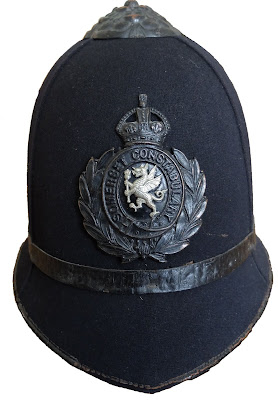 |
| Somerset Constabulary Edwardian period helmet |
 |
| Matchstick wooden pegs were usually used to secure the helmet rose |
 |
| Christys makers mark is visible on the leather liner |
It's common to find helmet liners from this period coloured black rather than the green typically seen on later helmets.
 |
| Early 20th Century Somerset Constabulary |
Helmet plates
 |
| Early Somerset Constabulary helmet plates 1901-1930's |
The three examples shown above are the first design of helmet plate for Somerset Constabulary during the period 1901 to around 1935. This wreath design was replaced in the 1930's with what's known as the Brunswick star which has remained the standard helmet plate for most Police Forces throughout England and Wales. Before this time Somerset county helmets were plain without any helmet plate. The 'dragon' in the centre is usually referred to as the
Wyvern. The Wyvern made a return to Avon & Somerset helmet plates in the late 1980's and continues to be used today.
1. This first example looks like a metal detecting find based on its condition. It's made from thin pressed brass. The crown has snapped off and the copper lugs on the rear are missing. This damage may have been the reason it was originally discarded. Not many collectors would be interested in something in such poor condition but it has historical interest. There is a hole drilled into the centre of the Wyvern design. The centre hole was used to fit a new version of the Wyvern holding a 'mace', which was introduced in 1911.
 |
| With updated Wyvern centre |
 |
| Fitted with the updated Wyvern centre |
 |
| Rear showing nut and bolt fixing for the updated Wyvern |
Here's another version of the same helmet plate. On closer inspection it can be seen that the crown has a small crack and no doubt prone to snapping off like the example above. The construction is very thin and was perhaps an interim helmet plate.
 |
| A small crack line is visible at the bottom of the crown |
2. This second helmet plate made from blackened brass has the new Wyvern centre held in place with a screw and nut fixing. A similar version sold on eBay in July 2015 for £111.69. However, this prompted several more to appear which pushed the price down to around £60. Sometimes it pays not to get caught up in a bidding war.
 |
| Somerset Constabulary helmet plate 1911 version |
A comparison of the above helmet plate with another of the same type:
A pair of helmet plate centres.
3. This next version is made from thicker nickel plated brass. The Wyvern centre has a mace but is moulded into the helmet plate which suggests it was a later issue. The copper lugs on the rear have been cut off. There is a small lump of solder in the centre of the rear which suggests it was previously mounted onto something, possibly as a retirement or presentation gift. As with the first helmet plate, most collectors would not be so interested in this because of the modifications.


The next helmet plate has the Brunswick star design introduced in the 1930's. What makes this rather worn looking version interesting is that it's fitted with an old type of Wyvern centre with nut and screw fixing. The same Wyvern which was fitted to the previous wreath design helmet plates. It should have had a fixing similar to the Queen's crown version shown further below in this section. Instead, a whole has been crudely made as seen in the second photo. It's possible such a modification was made 'in-service' in an attempt to re-use some of the old stock of Wyvern centres. However, since it was done so crudely, it could be a modern conversion by a collector or dealer in an attempt to 'restore' it. The correct fixing for the Wyvern on this helmet plate was a metal pin (see comparison). Wyvern centres used on later helmet plates had a split pin fixing which was attached to a slot in the helmet plate (see Queen's crown version).
 |
| Somerset Constabulary helmet plate 1935-1952 |
 |
| Without the Wyvern centre |
In the comparison below the helmet plate on the left has been painted black on the front only and the other helmet plate is blackened brass throughout. Note that the newer Wyvern centre on the right is a fraction bigger and more 'silver' in colour.
 |
| Somerset Constabulary helmet plate Wyvern comparison |
 |
| The correct fixing for this plate is a metal pin as shown on the right |
 |
| Somerset Constabulary black and chrome helmet plates 1953-1967 |
Some Police Forces such as the London Metropolitan Police used a black helmet plate until it was replaced by a chrome version in 1965. Other Police Forces used one helmet fitted with a black helmet plate for night duty and another fitted with a chrome helmet plate for daytime duty. I believe that Somerset Constabulary used black helmet plates for both day and night duty. They introduced a chrome version about the same time as the London Metropolitan Police. This may explain why some Somerset Constabulary helmets were issued with a black helmet rose top and chrome helmet plate combination. I've added more about this in my post on Somerset & Bath Constabulary.
The London Metropolitan Police changed from black to chrome helmet plates in 1965. Ranks of sergeant and above were issued with a chrome helmet plate and a blue enamel centre ring. By the 1990's all London Met Police helmet plates issued had a blue centre ring which was no longer enamel but simply painted.
 |
| Somerset Constabulary helmet plate comparison rear view |
 |
| Somerset Constabulary motorcycle helmet plate 1 |
The helmet plate above has been modified by removing the lugs and fitting a slider to the rear. This type of modification was used when fitting helmet plates to the early style of motorcycle helmet. Note also with this example that the helmet plate point is missing at the bottom. Although one would assume this was broken, it was in fact removed on purpose so it would fit the type of motorcycle helmet used during the 1960's period as seen below. The standard helmet plate was designed for the much taller custodian cork helmet. Rather than produce a different version as did the London Metropolitan Police, it was simply modified.
 |
| 1960s era Somerset Constabulary motorcycle helmet without the badge. The single hole is for the slider fitting. |
 |
Somerset Constabulary motorcycle helmet c. 1960s. The bottom tip of the helmet plate has been removed to fit the helmet.
|
 |
| Somerset Constabulary motorcycle officer c.1960s |
 |
| Somerset Constabulary 1960's |
 |
| The London Met Police adopted a black version fitted with a cap badge as shown here in 1954 |
This next example is an older version because it has a separate 'Wyvern' centre which is secured on the reverse by a pin (behind the slider fitting). Once again, the bottom tip of the brunswick star has been removed so it fits on the shallow motorcycle helmet as seen in the photographs above.
 |
| Somerset Constabulary motorcycle helmet plate 2 |
This third example with a slider fitting has been carefully hand-painted. Painted helmet plates were not used in-service. Such helmet plates would most likely have been painted for a retirement presentation gift or painted post-service by a collector. However, it's been documented that Bristol Constabulary had a number of their chrome helmet plates hand-painted for use with their ceremonial helmets. I have also seen a metal chrome Avon & Somerset Constabulary helmet plate with the centre painted black in a similar way as the example below, leaving the ER highlighted in chrome.
 |
| Somerset Constabulary motorcycle helmet plate 3 |
Finally, a fourth example of a helmet plate fitted with a slider on the back. In this case the tip on the bottom of the brunswick star is intact. The slider fitting used here is the same as those used on cap badges and is stamped with the makers name, Firmin, London.
 |
| Somerset Constabulary motorcycle helmet plate 4 |
Other badges
This Special Constabulary brass lapel badge dates from the WW1 period. It measures about 3cm in diameter, which is the same size as the later versions also shown below. It's fair to say this version is scarce and valued at £50-£60. It's made from brass with enameled red and blue. There are no makers marks. Although made of brass, photographs can make it appear silver or brown in colour.
 |
| Somerset Special Constabulary lapel badge |
 |
| J. R. Gaunt London, makers stamp on rear |
The badge shown above was issued to Special Constables between 1939 and 1945. It was typically worn on a jacket lapel in the absence of a full uniform. It's made of brass with a blue enamel outer ring. These were made by J.R Gaunt of London and individually numbered.
Two other variants of this badge exist and are shown below. Both have a red enamel Wyvern centre but one also uses white. I believe the badge shown at Fig.1 was issued to Sergeants and the other Fig.2 with the white shield was issued to Inspectors. These do not appear for sale very often and valued at about £40-£50. The standard version without an enamel Wyvern centre would sell for about £15.
 |
| Fig. 1 | |
 |
Fig. 2
|
Here is a cast iron die used for making the badges shown above. The diameter is 3.5cm and the height of the die is 2.5cm. It weighs 242g. Although this is a rather unique item, it deosn't hold much monetary value.
 |
| Cast iron Somerset Special Constabulary badge die |
 |
| Reverse of the metal die |
 |
| Somerset Constabulary cap badge 1901-1910 |
The cap badge above can be dated between 1901 and 1910. This is because it has the kings crown (post queen Victoria) and the Wyvern centre does not have the mace, which was added from 1911. It measures 2.25" high and 1.5" diameter. This badge sold for £111on eBay in June 2016. The value reflects its' rarity.
This next cap badge belonged to a lady who served with the Womens Auxiliary Police Corp during WW2. These cap badges are very common and are frequently found on eBay. Expect to pay £5-£8. Curiously, I've yet to see a Somersetshire Constabulary 'other ranks' cap badge with a Queens crown (1953-1967).
 |
| Somerset Constabulary cap badge 1935-1952 |
 |
| Rear slider fixing |
 |
| Somerset Constabulary cap badge and lapel/collar badge comparison |
The collar badge measures 1" diameter by 1.5" high and was worn by senior officers on their tunic lapels as shown in this 1940's era photograph below. It has two lugs on the rear. The collar badge is relatively rare and could be mistaken as a standard cap badge if seen from a photograph without any measurements. The two examples below are made of heavier weight metal compared to the chrome example above. These ones are likely to be older.
 |
A matching pair of Somerset Constabulary lapel badges
|

 |
Somerset Constabulary senior officer with the lapel badges
|
 |
Somerset Constabulary senior officers 1954
|
The photograph above is interesting in that only one of the two are wearing the small Somerset Constabulary lapel badges. This was a transitional period during which time these badges were being withdrawn. All badges issued following the Queens Coronation of 1953 featured what's known as a Queens crown with a different design. It must have been decided at that point they would not replace the outgoing badges with new versions featuring a Queens crown.
 |
| Somerset Constabulary epaulette badges 1960's |
 |
| 'Mock up' Somerset Constabulary epaulettes old and newer style |
An 'S' designation was used on epaulettes in the early 20th century before being replaced by the Wyvern shield during the 1960's.
 |
| Sgt. John Durston, Somerset Constabulary 1967 |
A 1960's Somerset Constabulary tunic.
 |
Waist belt and Somerset Constabulary tunic buttons
|
 |
Wyvern shield epaulette badge and officer's personal number 731
|
 |
Stamped on the inside lining with the year 1965
|
 |
Epaulettes have been sewn down for safety
|
The photographs above show a 1960's Somerset Constabulary tunic. Whilst this tunic is not in the best condition with several moth holes, its rarity makes it a nice item. Somerset Constabulary tunics like this with the original collar numbers and Wyvern shield are now very rare. The Wyvern shield epaulette badge was withdrawn following the amalgamation with the City of Bath Police in 1967. A tunic such as this has more historical value than monetary.
This printed fabric badge was produced for the Somerset Police Rugby Football Club. The blue square measures 10.5cm x 11cm. It probably dates from the early 1960s.
These next pin badges date from the WW1 period and made from thick cardboard backed with leather. It's remarkable such 'temporary' badges have survived over 100 years. Police Forces have always encouraged and supported sports events and these badges would have been produced for that purpose. They were made by a printing company Frank C Jenkins Co Ltd of Rupert Street, Bristol who were trading at the turn of the 20th century until at least the 1950's. These type of badges are not generally very collectable since they are not service issue badges. Because of this they do not hold monetary value but certainly hold historical value. Even today it's not uncommon for Police sporting events to have sponsored merchandise produced.
In 2023 I donated these to the Avon & Somerset Police museum.
Buttons
 |
| Victorian era tunic button. Herbert & Co. |
 |
| Edwardian era tunic button 1902-1911. Dolan & Co, Bond St Vauxhall, London. |
 |
| Tunic button c.1912-1930 |
 |
| Tunic button c.1930's. Herbert & Co. Ltd. London. |
 |
| Tunic button c.1935-1952 |
 |
| Tunic button 1952-1967 |
 |
| Cape/greatcoat black horn button c.1935-1952 |
Bridgwater Police tunic button
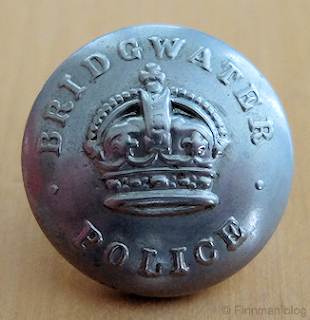 |
Bridgewater Police tunic button
|
 |
Bridgwater Police button reverse
|
Bridgwater Borough Police was a police force responsible for policing the borough of Bridgwater, Somerset in England from 1836 to 1940. It was subsequently amalgamated into the Somerset Constabulary in 1940. Anything relating to this Police Force is genuinely scarce as there were only about 20 constables employed during it's existence. This is why I don't have a separate page for Bridgwater Police.
This scarce Bridgwater Borough Police helmet plate appeared on eBay in November 2010 and sold for £350. It appears the seller found it following a clear-out and didn't have any idea of it's value. Since it's a numbered helmet plate, it would be possible to research the owner. It was issued between 1902 and 1935 before the design was changed. A genuinely scarce item.
Other items
In recent years, medals have become highly collectible and prices have steadily increased. This is certainly true of military medals and could be attributed to renewed interest in the two world wars and also the fact that it's much easier to research medals and their owners using the internet. This also means that there are now a large number of good quality replicas which could be passed on as originals. Fortunately there are still many Police awards like the
Special Constabulary long service medal below which can be purchased for around £15-£20 from eBay. This particular example was issued to a Somerset Special Constable. Those with the original box and paperwork can sell for more at £20-£40.
 |
| Somerset Special Constable long service medal circa 1919-1935 |
The whistle below belonged to an officer who served with Somerset Constabulary during the 1920's-1940's period. It has no stamp for "Somerset Constabulary" so without the additional information I have its
provenance would never be known. The maker is shown as J. Hudson & Co. and address is 244 Barr Street, Birmingham which dates the whistle after 1909. Police whistles are frequently available on eBay and 'anonymous' ones like this without the chain are relatively cheap to buy. More information on Police whistles can be found at this excellent website: http://www.whistleshop.co.uk/
This next whistle was issued to an officer who retired from Avon & Somerset Constabulary in 1982 having served the full 30 years. I believe this whistle was probably issued to him when he joined in 1952. Somerset Constabulary whistles were not stamped with the Police Force name, unlike Bristol Constabulary, who did.
Somerset Constabulary Notebook WW2 era
This wartme era notebook belonged to a Special Constable. It retains the original pencil which appears to be unused. The pencil slides into a side pocket.
 |
| 1950's/60's beer mat |
Womens Auxiliary Police Corp
Personal items and photographs can lead to the identification of the individual which adds to the historical interest. These next photographs were acquired together with the other items also shown. They belonged to Gladys Tuck who served with Somerset Constabulary Womens Auxiliary Police Corp (WAPC) during World War Two. Auxiliary Police Woman (APW) Gladys Tuck was one of many women recruited during WW2 to cover the shortfall created by regular Police officers who enlisted. No doubt this also helped towards a shift in acceptance of more women into the Police service.
These photographs provide a good record of the uniform worn at that time. The uniform is the same as that worn by regular officers but with a WAPC badge sewn onto the top of each arm. The badge is not quite visible in the photo below. I have included a photograph of the cap badge which belonged to Gladys further above. Gladys resigned from the Somerset Constabulary at the end of the war in 1945.
 |
| APW Gladys Tuck is highlighted here |
 |
| APW Gladys Tuck |
Items owned by Gladys Tuck
 |
| Somerset Constabulary Athletic Club Rules |
 |
| Police diary 1945 |
 |
| Somerset Constabulary Road Accident Report 'aide-memoire' |














































































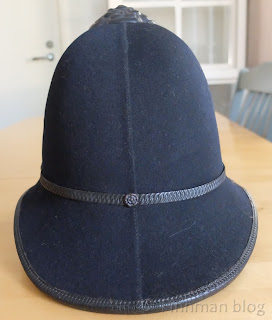







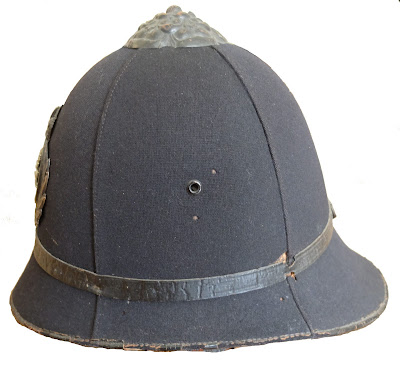





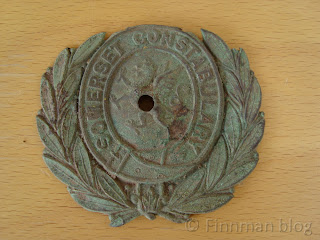





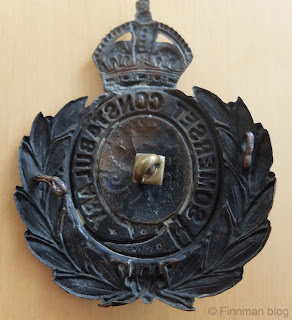





















































Thanks for assembling and taking the time to Post this fascinating background!
ReplyDeleteGreat information for collectors.
Thanks for the good feedback!
ReplyDelete